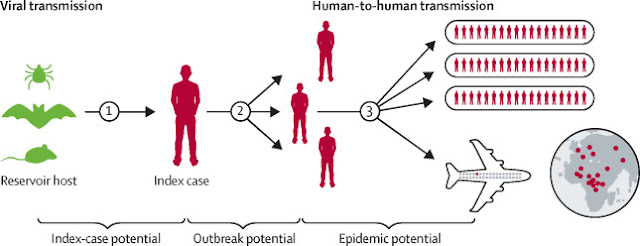The word 'pandemic' comes from the Greek 'pan,' meaning 'all,' and 'demos,' meaning 'people.' WHO (the World Health Organization) uses a six-stage classification system to show how a virus becomes a pandemic. It starts with infecting animals, then moves from animals to a few people, then begins to spread between people. This is an epidemic (meaning 'upon the people.') After this, the area affected begins to spread until it is worldwide. This worldwide exposure is called a pandemic.
Some of the worst plagues throughout world history include:
- Typhoid Plague of Athens - 430 BC
- Antonine Plague of the Roman Empire (believed to be smallpox) - 165-180 AD
- Plague of Justinian in Europe (first outbreak of the bubonic plague) - 541-740 AD
- Black Death in Europe - 1300 -1350 AD (killed 30-60% of the population)
- Third Pandemic of Bubonic Plague in China & India - 1800
- Cholera in India - 1816-1826
- Spanish Influenza (worldwide) - 1918-1919 (affected 25% of world population)
- Asian Influenza (milder than Spanish) - 1957
- Hong Kong Influenza - 1968 (over one million deaths)
- HIV/AIDS Pandemic (worldwide) - first diagnosed 1981 (over 32 million deaths since first diagnosis)
- Fever 1793
- An epidemic of fever sweeps through the streets of 1793 Philadelphia in this novel from Laurie Halse Anderson where "the plot rages like the epidemic itself" (The New York Times Book Review). During the summer of 1793, Mattie Cook lives above the family coffee shop with her widowed mother and grandfather. Mattie spends her days avoiding chores and making plans to turn the family business into the finest Philadelphia has ever seen. But then the fever breaks out. Disease sweeps the streets, destroying everything in its path and turning Mattie's world upside down. At her feverish mother's insistence, Mattie flees the city with her grandfather. But she soon discovers that the sickness is everywhere, and Mattie must learn quickly how to survive in a city turned frantic with disease.
- Ten Worst Epidemics in US History
- Philadelphia Under Siege
Make / Do
- Imagine you are lying in a hospital bed, recovering from yellow fever. Using sensory language, write a letter to your mother about your experience with the fever and in the hospital.
- Advanced unit on the 1918 Spanish Flu
- In depth unit on the Ebola virus
- Deliver a paper on behalf of the World Health Organization on the effects of a pandemic. Select a pandemic from history, and research it.
- What caused the pandemic?
- What were the symptoms and effects?
- How was it transmitted? How was it contained?
- How many people died? How many were affected?
- What solutions would you put in place to prevent another occurrence of this pandemic?
Vocabulary
- rouse
- abhorred
- lather
- disreputable
- puckish
- miasma
- bilious
- noxious
- fervent
- tedious
- vile
- respite
- pestilence
- fractious
- lancet
- odiferous
- jaundiced
- placid
- abates
- ominous
- fetid
- Foreshadowing is an advance sign or warning of what it to come in the future. Why is it significant that a mosquito in the opening chapter bites Matilda? What might the mosquito bite foreshadow?
- When the news spreads that the President is back in town, the people begin to come back home. How is the President's arrival a sign of hope?
Access all of the science studies in the Science-Based Novel Studies Bundle!
- Each unit has introductory text, which will give the student basic background information about the topic at hand.
- There are photographs and illustrations, and we have also included primary documents when available.
- After this text, there are featured videos, which augment the background information and help make the topic more accessible for more visual students.
- You will also find a short list of reading books, including one featured novel – the spine of the unit.
- There are vocabulary words, places, and people to identify.
- Reading comprehension, critical thinking questions, and writing assignments are included.
- We add fun with hands-on activities and extra videos to watch that will bring the era to life.
- Some units also have cooking projects.
Product Samples – Fever 1793 & Nick and Tesla: High Voltage Danger Lab
These studies are directed toward upper grades students, but some have resources for younger students so that the whole family can work together. Our family has used unit studies as curriculum for many years, and we hope that your family will enjoy these, too!





I love studying science and history together. Thank you!
ReplyDeleteIt really is fascinating to consider how the world has been shaped by epidemics and pandemics. Another great book to read is The Ghost Map by Steven Johnson. It recounts the history of the London cholera epidemic and how John Snow figured out what was causing it. A great story of how to follow the science, even when it goes against the accepted science of the day. My only caution is that it does use the 4 letter word for feces a bit, so determine for yourself if it’s appropriate for your kid to read.
ReplyDeleteThat sounds like one that could be good for high school...thanks for the suggestion!
DeleteThis is so cool! Thank you Yvie for your high quality research and materials.
ReplyDeleteDebbie :)
www.homeschoolingdietitianmom.com
This is interesting! It makes me consider the coronavirus, though...it's quite scary to think that it could spread like this.
ReplyDeleteSounds like such an interesting unit!
ReplyDelete